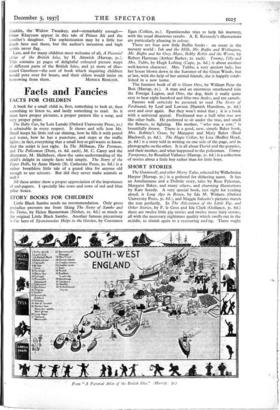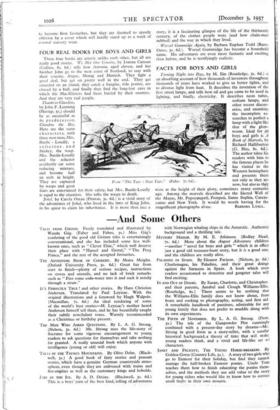Facts and Fancies
FACTS FOR CHILDREN
. • A book for a small child is, first, something to look at, then something to listen to, and lastly something to read. So it must have proper pictures, a proper pattern like a song, and very proper print. - - The Baby Car, by Lois Lenski (Oxford University Press, 2s.) is admirable in every respect. It shows and tells how Mr. Small keeps his little red car shining, how he fills it with petrol and water, how he has a puncture, and stops at the traffic lights; in fait, everything that a small boy or girl wants to know. And the script is just right. In The Milkman, The Postman, and The Policeman (Dent, Is. 6d. each), M. C. Carey and the illustrator, M. Shillabeer, show the same understanding of the child's delight in simple facts told simply. The Story of the Paper Dolls, by Anne Harris (St. Catherine Press, 2s. 6d.) is a rather breathleis little "tale of a grand idea for anyone old enough to use scissors. But did they never make animals as well ?'
All these artists show a proper appreciation of the importance of end-papers. I specially like rows and rows of red and blue pillar boxes.
STORY BOOKS FOR CHILDREN
Little Black Sambo needs no recommendation. Only gross prejudice prevents me from liking The- Story--of :Sambo and the Twins, by Helen Bannerman (Nisbet, Zs. 6d.) as much as the original Little Black Sambo. Another famous_ Piccaninny is ele hero of Epaminondas Helps in the Garden, by Constance Egan (Collins, 2s.). Epaminondas tries to help his mammy, with the usual disastrous results. A. E. Kennedy's illustrations are particularly pleasing in colour.
There are four new little Buffin books : an event in the nursery world : Ink and the Milk, Mr. Buffin and Wellington, Mr. Buffin and his Grey Mare, Bobby Robin and the Worm, by Robert Hartman (Arthur Barker, 2s. each). Tommy, Tilly and Mrs. Tiibbs, by Hugh Lofting (Cape, 3s. 6d.) is about another well-knoWn character: Mrs: Tubbs; a very ancient lady, has her house blown down in the Summer of the Great Winds, but at last, with the help of her animal friends, she is haPpily estab- lished in a new home.
" The funniest book of all is Giant Otto, by William Pene du Boil (Harika, 2s.). A man and an enormous otterhound join the Foreign Legion, and Otto, the dog, finds it really quite easy to beat eight hundred and fifty-two Arabs, and ten camels.
Parents will certainly be pestered to read The Story of Ferdinand, by Leaf and Lawson (Hamish Hamilton, 3s. 6d.) over and over again. But they won't mind that ; it is a book with a universal appeal. Ferdinand was a bull who was not like other bulls. He preferred to sit under the tree, and smell the flowers, to fighting. His mother, " who was a cow," is beautifully drawn. There is a good, new, simple Baker book, Mrs. Bobbity's Crust, by Margaret and Mary Baker (Basil Blackwell, 3s. 6d.). The Magic Collar, by Lisa (Bodley Head, 3s. 6d.) is a story told in writing on one side of the page, and in photographs on the other. It is all about David and the puppies, and their mother, and what happened to the policeman. Timmy Turnpenny, by Rosalind Valiance (Harrap, 2s. 6d.) is a collection of stories about a little boy rather than for little boys.
SHORT STORIES
The Gurmiwolf, and other Merry Tales, selected by Wilhelmina Harper (Harrap, 5s.) is a godsend for dithering aunts. It has an Ameliaranne and a Dolittle story, tales by Rose Fyleman, Margaret Baker, and many others, and charming illustrations by Kate Seredy. A very special book, just right for reading aloud, is Long Ago in Rouen, by Ida M. Withers (Oxford University Press, 3s. 6d.), and Maggie Salcedo's pictures match the text perfectly. In The Adventures of the Little Pig, and Other Stories, by F. le Gros and Ida Clark (Gollancz, 3s. 6d.) there are twelve little pig stories and twelve more fairy stories, -all with the necessary nightmare quality which swells out in the middle, to shrink- again to a reassuring ending. These ought From "A Pictorial Atlas of the British Isles." (Harrap. 55.) to become firm favourites, but they_are doomed to speedy oblivion by a cover which will hardly stand up to a week of normal nursery wear.
FOUR REAL BOOKS FOR BOYS AND GIRLS
These four books are utterly unlike each other, but all are really good stories. We Met Our Cousins, by Joanna Carman (Collins, 8s. 6d.) tells how Antonia, aged eleven, and her brother John go to the west coast of Scotland, to stay with their cousins, Angus, Morag and Hamish. They fight a good deal, but get on pretty well in the end. They get stranded on an island, they catch a burglar, ride ponies, are chased by a bull, and finally they find the long-lost cave in which the MacAllisters had been buried by their enemies. And they are very real people.
From "This Year : Next Yaar." (Faber. 7s. 6d.) Jobe!, by Carola Oman (Pitman, 3s. 6d.) is a vivid story of the adventures of Johel, who lived in the time of King John, in his quest to claim his inheritance. It is more than just a story, it is a fascinating glimpse of the life of the thirteenth century, of the clothes people wore (and how chain-mail rubbed) and the way in which they lived.
Worzel Guntrnidge Again, by Barbara Euphan Todd (Burns Oates, 3s. 6d.). Worzel Gummidge has become a household name. His adventures are even more fantastic and exciting than before, and he is terrifyingly realistic.
FACTS FOR BOYS AND GIRLS
magnificent photographs alone. BARBARA LYALL.



























































 Previous page
Previous page